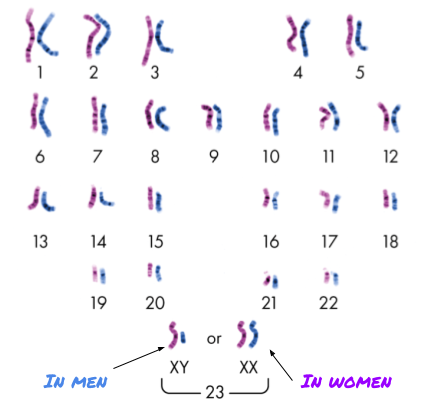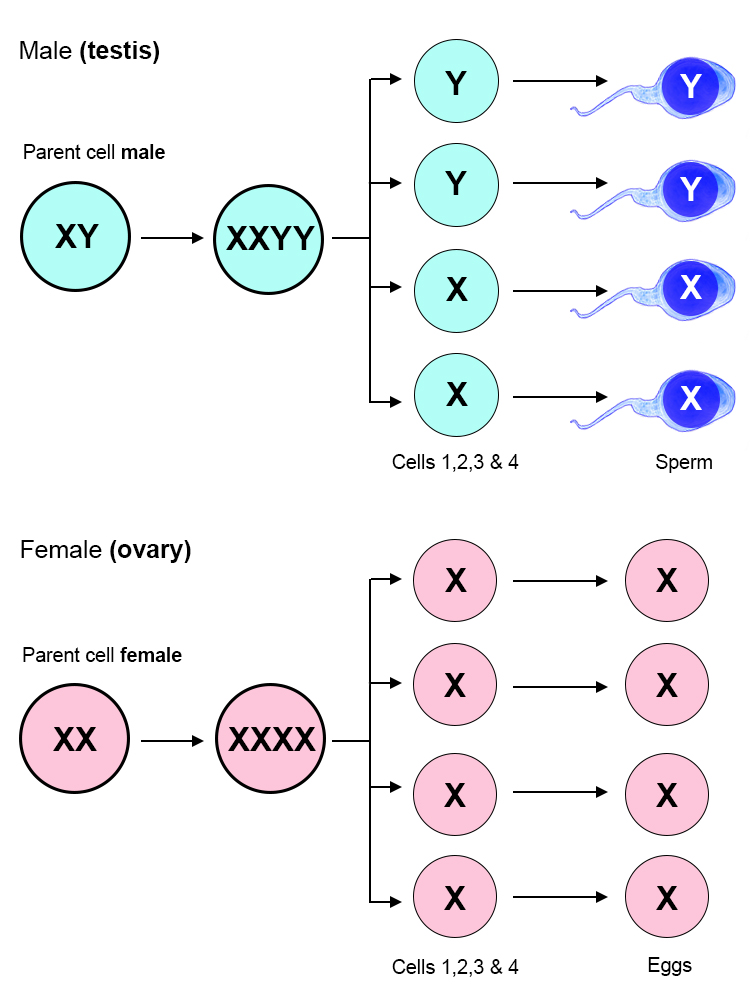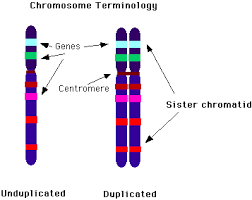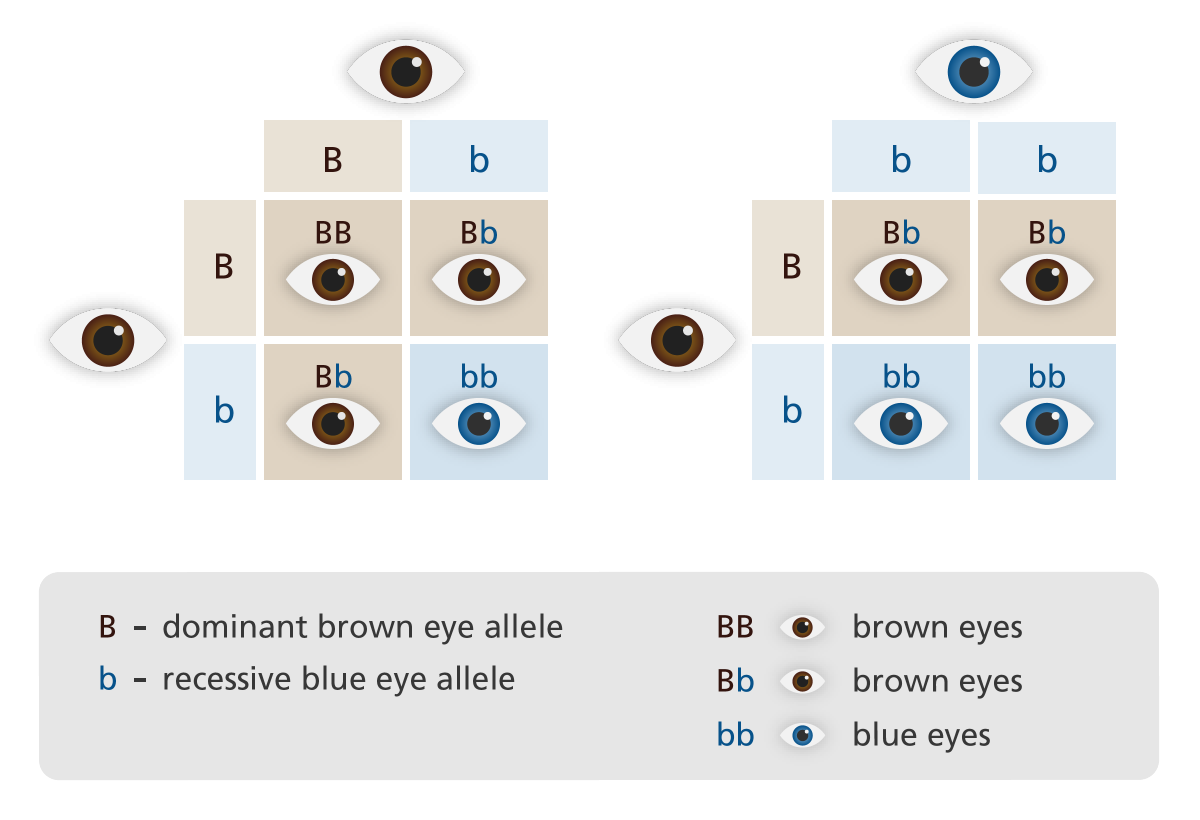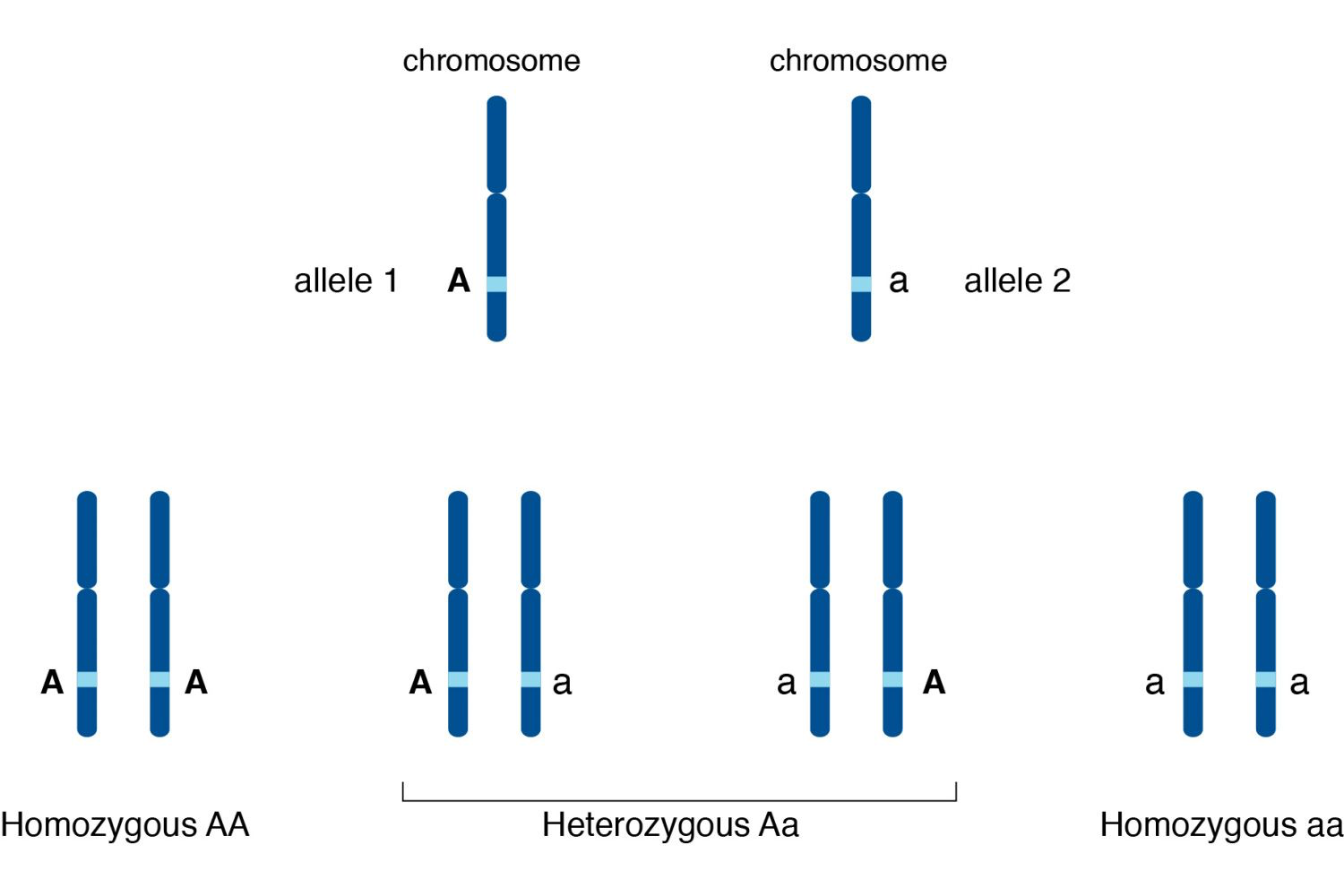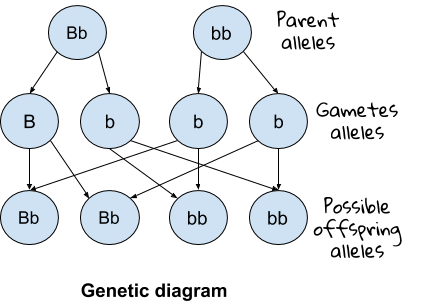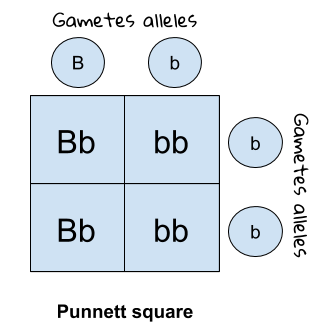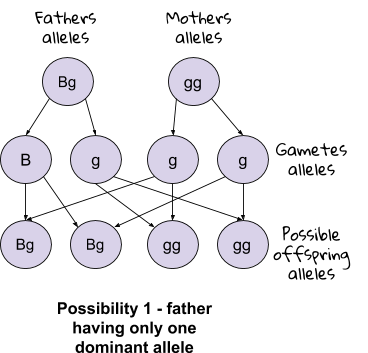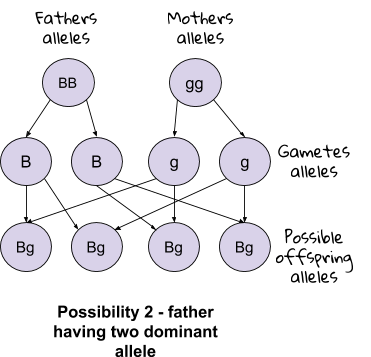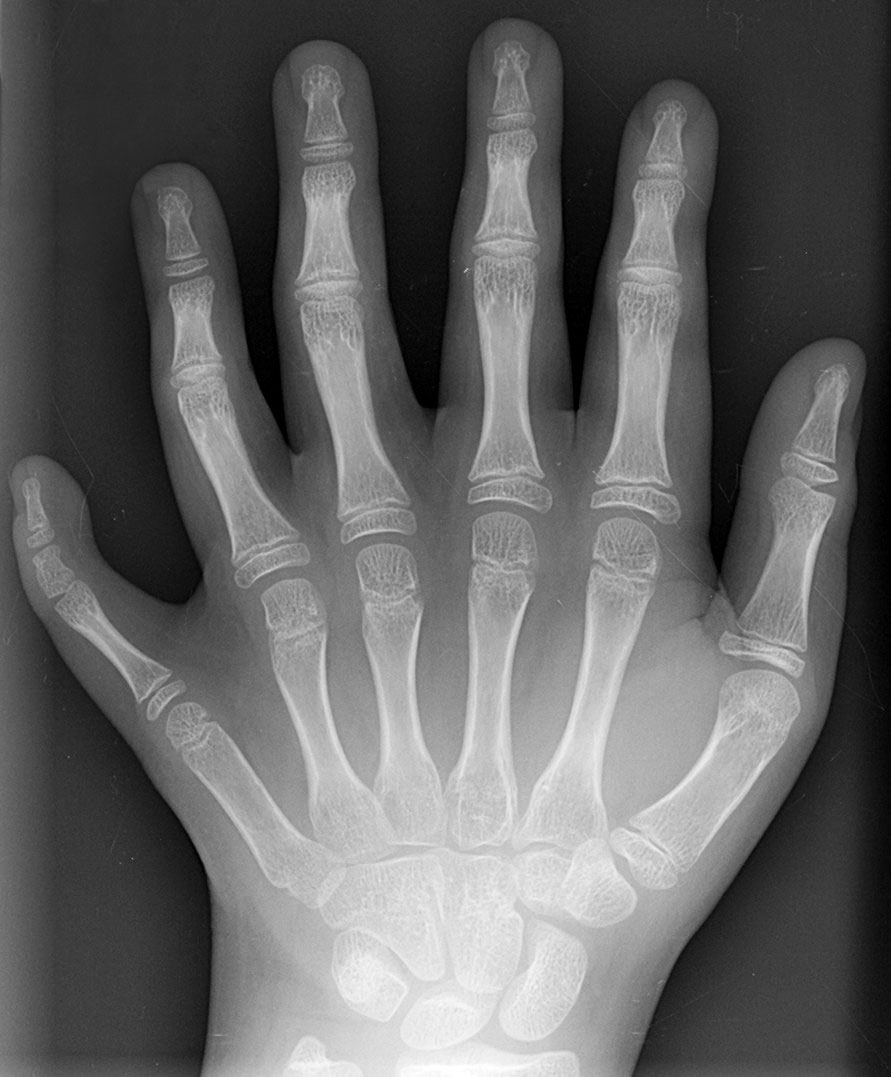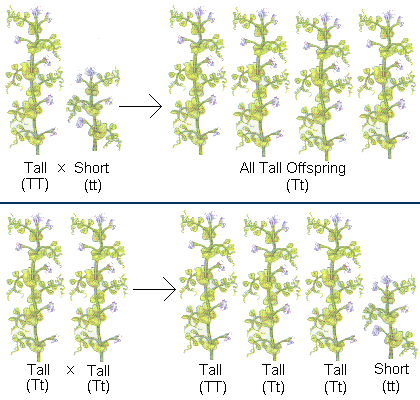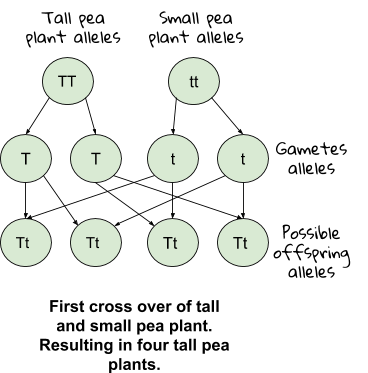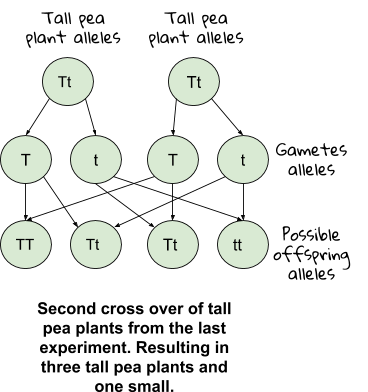Genetics
XAnd YChrommosomes
Each cell (apart from egg and sperm cells) contains 23 pairs of chromosomes in their nucleus (so there are 46 chromosomes all together). All of these chromosomes are different, with the 23rd pair being different in men and women. Men have one X and one Y chromosome, whereas women have two X chromosomes.
When making sperm cells through meiosis (occurs in the testes of men), the X and Y chromosomes are replicated and separated from their partner, just like all the other chromosomes. This means that two of the four sperm cells will contain an X chromosome, and two will contain a Y chromosome.
When making egg cells through meiosis (occurs in the ovaries of women), the X and X chromosomes are replicated and separated from their partner, just like all the other chromosomes. This means that all four egg cells contain one X chromosome.
When a sperm fertilizes the egg, the two half sets of chromosomes combine to make a full set of chromosomes. The gender of the offspring depends on if the fertilizing sperm contained an X or a Y chromosome. The likelihood of the offspring being male or female is 50:50.
Alleles and Genetic Diagrams
Genes
A gene is a section of DNA which defines something of your character. For example, one gene will define your hair colour, another will define the colour of your eyes. There is a large number of genes within each chromosome.
Alleles:
Each normal cell has 23 pairs of chromosomes. Each pair consists of two different chromosomes of the same type, one from the biological mother and one from the biological father. Genes exist in different versions. These versions are called alleles. Below is shown two different alleles for the same gene. Genes are usually labelled with letters.
Alleles can either be dominant (shown with a capital letter, i.e. ‘A’) or recessive (shown with a small letter, i.e ‘a’). The code dominant alleles always trump recessive alleles.
For example:
Let’s say, for the gene for blue eyes, a child has two alleles. An allele for brown eyes (B) from their mother and an allele for blue eyes from their father (b). Since the allele from brown eyes is dominant and blue is recessive, the child will have blue eyes. In order for a child to have blue eyes, it needs to have two recessive alleles.
Genotype:
A genotype is the combination of alleles you have. I.e. BB is a genotype.
Phenotype:
A phenotype is the characteristic that you show because of your genotype. I.e. Brown eyes.
Alleles/genotypes can be heterozygous or homozygous
Hetero means ‘opposite’ and homo means ‘same’. A trait can be heterozygous if it has two dominant alleles or two recessive alleles (both the same). A trait can be homozygous if it has one dominant allele and one recessive allele.
Gene
Genetic diagrams and Punnett squares
You can show the probability of certain characteristics to be inherited with genetic diagrams and punnett squares (if you know the genotype of the mother and father).
Example:
The gene that causes humans to have brown hair is dominant, whereas ginger hair is recessive. If a ginger haired woman had a baby with a brown haired man, calculate the probability of the child having ginger hair and use a genetic diagram to show your working. There are two answers to this.
Answer:
Since ginger hair is recessive and the mother has ginger hair, we already know that both of her alleles are recessive ginger alleles. The father has brown hair, which means he has at least one dominant allele for brown hair (although he could have two).
First step is to draw out the two possible genetic diagram:
If the father is a carrier of ginger hair (has the recessive allele for ginger hair and a dominant allele for brown haired) then there is a 50% chance that the child will have ginger hair and 50% that they will have brown hair. However, if the father has two dominant brown hair alleles, there is 100% chance that the child will be born with brown hair and a 0% chance of them having ginger hair.
Inherited Disorders
There are two genetic disorders that you will need to know about:
Cystic fibrosis -
this is an inherited disorder of the cell membranes.
Thick sticky mucus is secreted in the air passages and pancreas of people with cystic fibrosis, this makes it difficult to breathe.
The allele for this is recessive.
__Polydactyly - __
this is an inherited disorder that causes children to be born with extra fingers or toes.
The disorder doesn’t affect anything else so is not life-threatening.
The allele for this is dominant.
You will likely get a question about the likelihood of people being born with these disorders, given their parents genotypes. This is done just like in the last section.
There are lots of genetic disorders that can be passed down from parents to offspring, some worse than others.
Embryonic screening
Inherited disorders can be detected before the child is born. It can be done in two ways:
- Preimplantation genetic diagnosis (PGD) - if an egg is fertilized using IVF (fertilized in the lab and inserted into the womb) then scientists can look at a sample of cells from each embryo and test whether they are healthy or not. The healthy embryos can be inserted into the womb and the unhealthy disposed of.
- Chorionic villus sampling (CVS) - This is a process that is carried out 10-13 weeks into pregnancy. The placenta and embryo develop from the same original cell. A sample of cells is taken from the placenta and their genes are analysed. If the placenta cell is found to have an inherited disorder, the parents can choose whether or not they want to terminate the pregnancy (have an abortion).
As you may have guessed, there is a lot of debate over whether Embryonic screening is a good or a bad thing. No matter your views, you’ll have to know the main arguments for and against embryonic screening.
Here are the top few:
Arguments for embryonic screening:
- During IVF, most of the embryos will be disposed of anyway, this just makes sure that the ones that are chosen are healthy.
- It stops people from suffering from severe genetic disorders.
- Parents don’t have to have a termination once they find out about a disorder. They have the choice to decide.
- It costs the government and taxpayer lots of money to treat genetic disorders.
- Embryonic screening helps to reduce the amount of people with genetic disorders and will reduce the likelihood of disorder being passed down generations
Arguments against embryonic screening:
- Embryonic screening implies that the lives of people with genetic disorders are not as valuable as people without genetic disorders.
- Rejected embryos are destroyed after PGD. Some people think that this is unethical since you are destroying life.
- There is a possibility that, in the future, embryonic screening becomes so advances that people can pick and choose their child’s look/characteristic. For example, choosing blonde hair and blue eyes.
- CVS could result in a miscarriage.
- This is an expensive process.
Mendel
Gregor Mendel was an Austrian Monk. His research kick started the way to modern genetics! Here is what he did…
Mendel had a section of land in the Monastery in which he would grow pea plants. He would often experiment on these pea plants.
For one of his experiment, he crossed tall pea plants with dwarf pea plants. He saw that all of the offspring from the first cross were tall. He then crossed two of these offspring with each other, he saw that this resulted in three tall pea plants and one dwarf plant!
Mendell was the first to show that characteristics can be ‘hidden’. That meaning that an organism can carry the genes for a certain characteristic, without displaying the characteristic itself.
This is what was happening, in terms of genetic diagrams.
